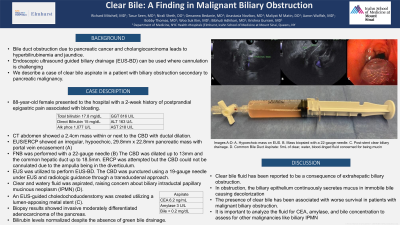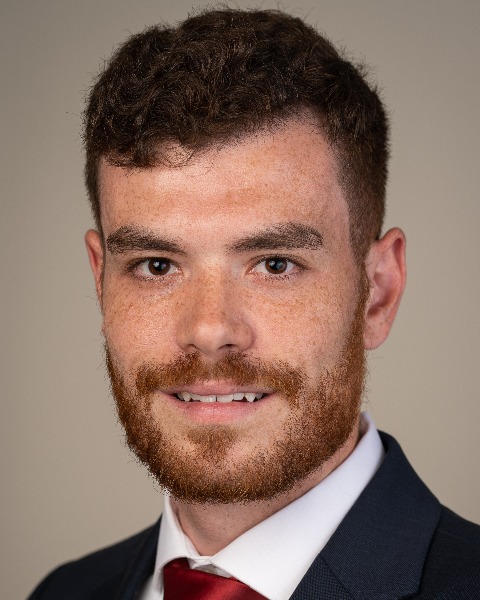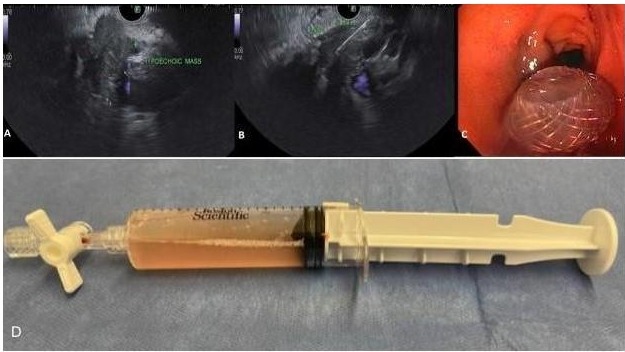Tuesday Poster Session
Category: Biliary/Pancreas
P3531 - Clear Bile: A Finding in Malignant Biliary Obstruction
Tuesday, October 29, 2024
10:30 AM - 4:00 PM ET
Location: Exhibit Hall E

Has Audio

Richard Mitchell, MD
Elmhurst Hospital Center / Icahn School of Medicine at Mount Sinai
Queens, NY
Presenting Author(s)
Richard Mitchell, MD1, Tasur Seen, MD1, Nirali Sheth, DO2, Genanew Bedanie, MD1, Anastasia Novikov, MD2, Maliyat M Matin, DO2, Aaron Walfish, MD1, Bobby Thomas, MD1, Woo Suk Kim, MD1, Bibhuti Adhikari, MD1, Krishna Gurram, MD2
1Elmhurst Hospital Center / Icahn School of Medicine at Mount Sinai, Queens, NY; 2Elmhurst Hospital Center / Icahn School of Medicine at Mount Sinai, Elmhurst, NY
Introduction: Obstruction of the bile duct due to pancreatic cancer and cholangiocarcinoma is recognized for inducing hyperbilirubinemia and jaundice. In situations where cannulation poses challenges, the utilization of endoscopic ultrasound guided biliary drainage (EUS-BD) emerges as a viable option. Here, we describe a case where a patient with biliary obstruction secondary to pancreatic malignancy had clear bile on aspiration.
Case Description/Methods: An 88-year-old female presented to the hospital with a 2-week history of postprandial epigastric pain associated with bloating. Total bilirubin was 17.8mg/dL, alkaline phosphatase 1,077U/L, gamma-glutamyl transferase 816U/L, alanine transaminase 163U/L, and aspartate aminotransferase 218U/L. Computed tomography of the abdomen showed a 2.4cm mass within or next to the common bile duct (CBD) with biliary duct dilation. EUS and endoscopic retrograde cholangiopancreatography (ERCP) showed an irregular, hypoechoic, 29.8mmx22.8mm pancreatic mass. Portal vein encasement was present, and a fine needle biopsy was performed with a 22-gauge needle. The CBD was dilated up to 13mm and the common hepatic duct up to 18.5mm. ERCP was attempted but the CBD was unable to be cannulated due to the ampulla being in the diverticulum. EUS was utilized to perform EUS-BD. The CBD was punctured using a 19-gauge needle under EUS and radiologic guidance through a transduodenal approach. Clear and watery fluid was aspirated, raising concern about biliary intraductal papillary mucinous neoplasm (IPMN). The aspirate was sent for amylase, bilirubin, and carcinoembryonic antigen (CEA) levels. An EUS-guided choledochoduodenstomy was created utilizing a lumen-apposing metal stent. Biopsy results showed invasive moderately differentiated adenocarcinoma of the pancreas. Fluid aspirate demonstrated CEA 6.2ng/mL, amylase 3U/L, and bile < 0.2mg/dL. Bilirubin levels normalized despite the absence of green bile drainage.
Discussion: We describe a case where clear bile was aspirated from the CBD of a patient with pancreatic malignancy. Clear bile fluid has been reported to be a consequence of extrahepatic biliary obstruction. In obstruction, the biliary epithelium continuously secretes mucus in immobile bile causing decolorization. The presence of clear bile has been associated with worse survival in patients with malignant biliary obstruction. It is also important to analyze the fluid to assess for other malignancies like biliary IPMN, which can occur rarely.

Disclosures:
Richard Mitchell, MD1, Tasur Seen, MD1, Nirali Sheth, DO2, Genanew Bedanie, MD1, Anastasia Novikov, MD2, Maliyat M Matin, DO2, Aaron Walfish, MD1, Bobby Thomas, MD1, Woo Suk Kim, MD1, Bibhuti Adhikari, MD1, Krishna Gurram, MD2. P3531 - Clear Bile: A Finding in Malignant Biliary Obstruction, ACG 2024 Annual Scientific Meeting Abstracts. Philadelphia, PA: American College of Gastroenterology.
1Elmhurst Hospital Center / Icahn School of Medicine at Mount Sinai, Queens, NY; 2Elmhurst Hospital Center / Icahn School of Medicine at Mount Sinai, Elmhurst, NY
Introduction: Obstruction of the bile duct due to pancreatic cancer and cholangiocarcinoma is recognized for inducing hyperbilirubinemia and jaundice. In situations where cannulation poses challenges, the utilization of endoscopic ultrasound guided biliary drainage (EUS-BD) emerges as a viable option. Here, we describe a case where a patient with biliary obstruction secondary to pancreatic malignancy had clear bile on aspiration.
Case Description/Methods: An 88-year-old female presented to the hospital with a 2-week history of postprandial epigastric pain associated with bloating. Total bilirubin was 17.8mg/dL, alkaline phosphatase 1,077U/L, gamma-glutamyl transferase 816U/L, alanine transaminase 163U/L, and aspartate aminotransferase 218U/L. Computed tomography of the abdomen showed a 2.4cm mass within or next to the common bile duct (CBD) with biliary duct dilation. EUS and endoscopic retrograde cholangiopancreatography (ERCP) showed an irregular, hypoechoic, 29.8mmx22.8mm pancreatic mass. Portal vein encasement was present, and a fine needle biopsy was performed with a 22-gauge needle. The CBD was dilated up to 13mm and the common hepatic duct up to 18.5mm. ERCP was attempted but the CBD was unable to be cannulated due to the ampulla being in the diverticulum. EUS was utilized to perform EUS-BD. The CBD was punctured using a 19-gauge needle under EUS and radiologic guidance through a transduodenal approach. Clear and watery fluid was aspirated, raising concern about biliary intraductal papillary mucinous neoplasm (IPMN). The aspirate was sent for amylase, bilirubin, and carcinoembryonic antigen (CEA) levels. An EUS-guided choledochoduodenstomy was created utilizing a lumen-apposing metal stent. Biopsy results showed invasive moderately differentiated adenocarcinoma of the pancreas. Fluid aspirate demonstrated CEA 6.2ng/mL, amylase 3U/L, and bile < 0.2mg/dL. Bilirubin levels normalized despite the absence of green bile drainage.
Discussion: We describe a case where clear bile was aspirated from the CBD of a patient with pancreatic malignancy. Clear bile fluid has been reported to be a consequence of extrahepatic biliary obstruction. In obstruction, the biliary epithelium continuously secretes mucus in immobile bile causing decolorization. The presence of clear bile has been associated with worse survival in patients with malignant biliary obstruction. It is also important to analyze the fluid to assess for other malignancies like biliary IPMN, which can occur rarely.

Figure: Images A-D: A. Hypoechoic mass on EUS. B. Mass biopsied with a 22-gauge needle. C. Post-stent clear biliary drainage. D. Common Bile Duct Aspirate: 5mL of clear, water, blood-tinged fluid concerned for being mucin
Disclosures:
Richard Mitchell indicated no relevant financial relationships.
Tasur Seen indicated no relevant financial relationships.
Nirali Sheth indicated no relevant financial relationships.
Genanew Bedanie indicated no relevant financial relationships.
Anastasia Novikov indicated no relevant financial relationships.
Maliyat M Matin indicated no relevant financial relationships.
Aaron Walfish indicated no relevant financial relationships.
Bobby Thomas indicated no relevant financial relationships.
Woo Suk Kim indicated no relevant financial relationships.
Bibhuti Adhikari indicated no relevant financial relationships.
Krishna Gurram indicated no relevant financial relationships.
Richard Mitchell, MD1, Tasur Seen, MD1, Nirali Sheth, DO2, Genanew Bedanie, MD1, Anastasia Novikov, MD2, Maliyat M Matin, DO2, Aaron Walfish, MD1, Bobby Thomas, MD1, Woo Suk Kim, MD1, Bibhuti Adhikari, MD1, Krishna Gurram, MD2. P3531 - Clear Bile: A Finding in Malignant Biliary Obstruction, ACG 2024 Annual Scientific Meeting Abstracts. Philadelphia, PA: American College of Gastroenterology.
